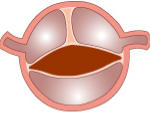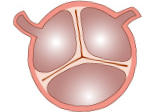


Disclaimer Privacy Policy
Copyright (c) 2021 Bicuspid Aortic Foundation, All Rights Reserved


Creating a Climate of Hope, an Atmosphere of Caring, and Information for All

Bicuspid Aortic Valve
Open BAV
The opening of a BAV resembles the open mouth of a fish, leading to the term “fish mouth” valve.
Bicuspid Aortic Valve Overview
The bicuspid aortic valve (BAV) may seem to be a very
simple birth defect of the heart. Perhaps this is because it
frequently does not require surgical treatment early in life.
There is no real way to predict if or when a bicuspid aortic
valve will fail due to stenosis and/or aortic insufficiency. A
bicuspid aortic valve may develop problems at different
stages of life, including infancy. Some BAVs may continue to
work well for an entire lifetime, but most will require
treatment at some point.
The valves of the heart are like one-way doors or gates.
They open and close to direct the flow of blood into and out
of the heart and between the chambers inside the heart. The
aortic valve is the gate between the main pumping chamber
of the heart, the left ventricle, and the main artery of the
body, the aorta. The aortic valve is able to open and close
because it has leaflets (cusps). In a normal aortic valve there
are three leaflets, and because of this it is called trileaflet.
The word bicuspid is used to describe an aortic valve that is
not normal; it has only two cusps or leaflets.
The highest pressure in the circulatory system is
experienced by the left ventricle, aortic valve, and ascending
aorta. When the heart muscle of the left ventricle contracts,
the aortic valve leaflets separate, making an opening and
allowing blood to flow from the heart into the aorta. When
the heart muscle relaxes, the leaflets fold back together,
closing the opening so that blood cannot flow back into the
heart again.
For proper blood flow, it is important for the valve leaflets to
open widely and then close tightly. The bicuspid aortic valve
may not function as perfectly as a trileaflet valve, but it could
open and close well enough to support normal life and
activity for some time.
As the drawings show, a bicuspid aortic valve generally
looks different than a trileaflet aortic valve. However, in
reality the malformation can be very subtle and may not be
found by routine echocardiography.
With time, a bicuspid aortic valve may begin to leak
(insufficiency, regurgitation), become narrowed (stenosis), or
do both of these. Calcification of the leaflets may occur. It is
also prone to bacterial infection, which is called endocarditis.
These valve-related complications are the part of bicuspid
aortic disease that is most well known.
It should be remembered that while the diseased aortic valve
is very important, it is only one part of this condition.
Repairing or replacing a bicuspid aortic valve addresses the
valve issue but not a diseased aorta.

Tricuspid Aortic Valve
A closed trileaflet aortic
valve and a closed BAV
may be difficult to tell apart.

BAV is Common
It is very likely that you
know someone with BAV.
It could even exist in your
family or extended family
without you knowing about
it.


- Aorta
- BAV and Other Heart Valves
- Blood Pressure
- Exercise/Weight Lifting
- Featured Papers
- Guidelines
- Familial TAAD
- History
- Honoring Dr. M.E. Abbott
- Pictures (graphic content)
- Pictures Valvular Strand, Aneurysm (graphic)
- Prosthetic Heart Valves
- Scientific Awards
- Spotlight on Research - Coming Soon
- Video (graphic content)




































